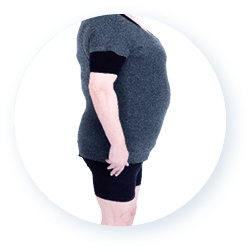
What are the common
features of lipodystrophy?
Generalised and partial lipodystrophy (GL and PL) are severe diseases with external signs that are visible and signs that can only be identified on examination. Signs and symptoms may manifest differently in each patient and not all occur in every patient. Even the same form of lipodystrophy can show different physical and metabolic symptoms, both in type and severity. Therefore, the appearance of patients with generalised and partial lipodystrophy subtypes can vary greatly.

What are visible signs of lipodystrophy?
There are various external signs that may indicate generalised and partial lipodystrophy. The essential sign is the lack of subcutaneous fat in the body.

Muscular appearance with prominent visible veins
The lack of subcutaneous fat and the fat deposition in muscles leads to a muscular appearance and the veins appear enlarged and protrude visibly. This is particularly noticeable on the arms and/or legs.

Enlarged hands and feet
Hands and feet, and also the jaw, can be enlarged. The precise cause of this is not known.
It is assumed that the high level of insulin, as a consequence of insulin resistance, may be responsible for the increased growth. These physical characteristics are described as “acromegaloid appearance”.

Increased abdominal girth and fatty liver
The stomach may look enlarged; the navel may protrude. This is caused by fat deposits in the internal organs such as the liver or in the spleen. The organs themselves increase in size due to the deposited fat and make the stomach look fat. An enlarged liver is called hepatomegaly.

Dark, velvet-like patches on the skin
In the area of the neck, the armpits, under the breast and in the groin, large, dark patches can appear on the skin, which feel soft. This is called “acanthosis nigricans”. These patches often appear in connection with high insulin levels.

Nodules that suddenly occur
These nodules are approximately 0.2 - 0.3 cm in size. They are large, yellow, hard and clearly defined and may also sometimes itch; they appear suddenly and mainly in large numbers, especially on the hands and feet, arms, legs and buttocks. This is called “eruptive xanthoma”. The nodules can appear when the fat in the blood (triglycerides) are too high.

Accelerated longitudinal growth
Children with congenital GL grow faster than other children. Their height increases at a greater rate
compared to their overall weight. This is known as “accelerated longitudinal growth”.
What are invisible signs of lipodystrophy?
The lack of subcutaneous fat can lead to low leptin levels and this can have effects on very many processes in the body. Pronounced metabolic disorders can occur and cause significant damage to the body. The extent of these metabolic consequences depends on the type of lipodystrophy and how seriously the person is affected.
Metabolic Changes
Some of the signs of partial or generalised lipodystrophy may be hard to recognise. Depending upon the severity of disease and extent of body fat loss, patients may be predisposed to several metabolic changes.
Insulin resistant diabetes
The storing of excess fat in the muscles or internal organs can lead to the development of insulin resistance. The body then no longer reacts to its own insulin to control blood sugar levels. This can lead to diabetes (diabetes mellitus). This can, in turn, lead to serious secondary diseases that can affect the kidneys, heart and eyes. A typical indicator of GL or PL is when diabetes is difficult to manage or very high doses of insulin are required, especially in children.
High triglycerides
Triglycerides are a type of fat (lipid) found in blood. The body converts any calories it doesn‘t need to use right away into triglycerides and stores them in fat cells. In GL and PL, the reduced subcutaneous fat means that higher triglyceride levels are found in the blood (hypertriglyceridaemia) because there aren‘t enough fat cells to store them in. This can have serious consequences including an increased risk of heart disease and pancreatitis (inflammation of the pancreas).
Fatty liver
Lipodystrophy can also cause an abnormal buildup of fats in the liver (hepatic steatosis), which can result in an enlarged liver (hepatomegaly) and abnormal liver function. This so-called non-alcoholic fatty liver disease (NAFLD) can eventually lead to liver fibrosis and cirrhosis as the disease progresses.
Abnormal Blood Sugar and Fat Levels
Abnormal storage of fat in the body can lead to severe health problems. In many lipodystrophy patients, the regulation of blood sugar levels is disrupted as patients develop insulin resistance, a condition where the body‘s tissues cannot adequately respond to insulin. They can develop a form of diabetes that requires very high doses of insulin (often over 200 units a day or more than 2 units/kg) to control blood glucose levels. Furthermore, lack of subcutaneous fat leads to higher triglyceride levels in the blood.
Normal blood triglycerides
Adults:
Under 2.3 mmol/L (204 mg/dL)
Children up to 3 years:
Under 1.1 mmol/L (100 mg/dL)
Children 4–15:
Under 1.3 mmol/L (110 mg/dL)
Young people over 16 years:
Under 1.4mmol/L (120 mg/dL)
Severe hypertriglyceridaemia
Over 5.65 mmol/L
(≥ 500 mg/dL)
Normal blood sugar
Fasting:
4.0-5.4 mmol/L (72–99 mg/dL)
2 hours post meal:
Up to 7.8 mmol/L (140 mg/dL)
Diabetes
Fasting:
7.0 mmol/L (126 mg/dL) or more
2 hours post meal:
11.1 mmol/L (200 mg/dL) or more
C-LD/UK/0092
Date of preparation October 2023